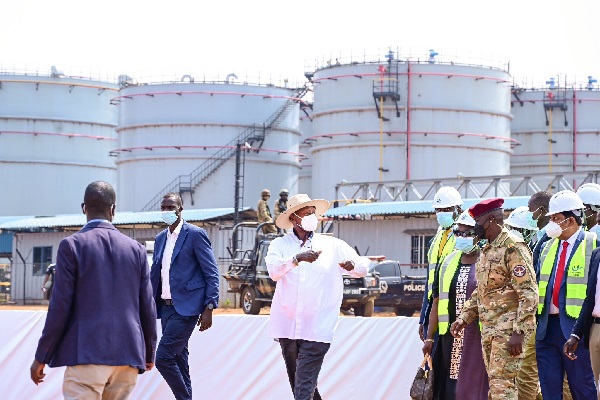
Kampala, Uganda | THE INDEPENDENT | Uganda’s economy is quite robust after weathering through several shocks in recent years, say top economists from the Africa Development Bank Group (AFDB).
While there has been concern about the increase in domestic and foreign debts, economists suggest that the Ministry of Finance and the Central Bank have managed the debt levels quite prudently.
The observations are part of the Africa Development Bank Group’s Country Focus Report 2024 on Uganda. Officials from the Bank released the report titled “Driving Uganda’s Transformation the Reform of the Global Financial Architecture” this week at a virtual briefing.
Peter Engbo Rasmussen, the Principal Country Economist at the African Development Bank Group in charge of Uganda and Nigeria however says Uganda’s economic growth in the recent decade has not reached the historical levels witnessed in the 1990’s and 2000’s.
“That would be important in terms of rising or moving quicker to a path of poverty or sustainable poverty reduction,” he said.
The economy did slow down in 2023 compared to 2022 due to declines in public administration food crops and manufacturing. In terms of price stability, Rasmussen says prices are coming down or inflation is reducing in line with the Central Bank’s medium-term target of 5%.
He explained that the poverty levels are partially related to the very high level of informality and the high cost of living that was experienced especially in 2022. The report also finds that Uganda’s labor productivity has been declining since 2011.
Uganda like many other countries weathered the 2011 global financial crisis whose effects are being witnessed to date. The country’s structural transformation has remained limited despite the government’s commitment to invest in some key sectors.
“There is a tendency to shift from low-value addition agriculture to low-value addition trading and personal services. Another thing that is very important in this context is also the development of institutions and governance to improve the capacity and efficiency of the public sectors,” said Rasmussen.
In 2015, Uganda embarked on infrastructure investments in structural transformation and economic development. The push went on until 2021 but was partly disrupted by the COVID-19 pandemic lockdowns.
In the early 2000s, Uganda’s development partners funded more than half of its budget and had gained significant influence over its priorities. Vision 2040 was grounded on national ambitions to own and control its development agenda.
Vision 2040 targets included reaching upper middle-income status of $9,500 per capita by 2040, reducing poverty to 5 percent of the population, and improving domestic savings to 35 percent.
AFDB said reaching upper-middle-income status would require structural shifts for the economy to grow by more than 12 percent a year over the next 20 years.
In terms of the economic outlook, the AFDB group is quite positive about Uganda’s GDP projected at 6% higher than in 2023.
The projected growth will be propelled by large oil and gas investments that are taking place but also, mining, manufacturing, and construction.
“We expect those sectors to do very well and actually in the first quarter of the year we are in, we saw this growth rise to 6.6%,” Rasmussen.
The AFBD’s figures are based on an annual basis and not a financial year basis. Inflation is expected to close at 5%. The African Development Bank Group had projected Uganda’s fiscal consolidation at 4.3% but the government said it to reduce deficits and the accumulation of debt at 5.7%of GDP.
That was because of high interest in domestic debt payments and an increase in development spending. The IMF last year released a report in which it reported that unprecedented surges in public debt in many countries since the COVID-19 pandemic have rekindled interest in fiscal consolidation.
It said although the debt-to-GDP ratios declined somewhat in many countries in the wake of economic recovery and higher-than-expected inflation in 2022, they remain elevated and above pre-pandemic levels in most countries.
Macroeconomic Performance and Outlook at Glance
Uganda’s real GDP growth slowed in 2023 to 4.6 percent, held back by contractions in food crop production and public administration, as well as flat manufacturing output.
Price pressures continued to moderate in 2023, with an average inflation rate of 5.5 percent. The economy is expected to expand 6.0 percent in 2024 and 7.0 percent in 2025, as oil companies continue to ramp up investments.
Higher growth and investment will sustain high levels of imports that will keep the current account deficit elevated over the medium term.
The government remains committed to fiscal consolidation driven by cuts in current and investment spending, more than increased revenue mobilization. The budget deficit narrowed or two consecutive years, to 5.1 percent of GDP in 2022/2023, and is estimated to decline to 4.2 percent of GDP in 2023/2024.
The economy stands to gain from tailwinds, as external risks to the growth outlook appear to be subsiding. As global prices continue to stabilize, global financial conditions will moderate and help further spur investment and boost growth in Uganda.
Domestic headwinds stem from delays in oil-to-market, lower tax revenue mobilization, and low efficiency in public investments.
To accelerate its structural transformation, Uganda will need to continue investing in public infrastructure and facilitate business development through improvements in the investment climate, spurring job creation in higher productivity sectors, and broadening the domestic revenue base.
Relevant higher productivity sectors include manufacturing, construction, and tourism, which tend to absorb unskilled and semi-skilled labor
*****
URN
 The Independent Uganda: You get the Truth we Pay the Price
The Independent Uganda: You get the Truth we Pay the Price



